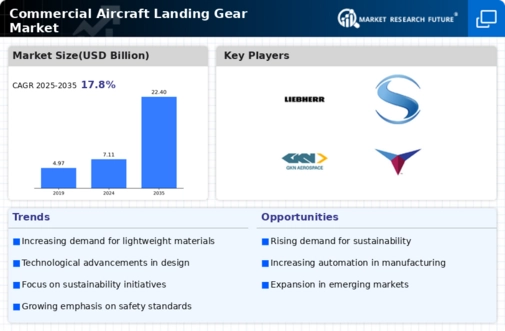Market Trends
Introduction
As we enter 2024, the Commercial Aircraft Landing Gear Market is poised for significant transformation driven by a confluence of macro factors. Technological advancements, particularly in materials science and automation, are enhancing the performance and reliability of landing gear systems, while regulatory pressures aimed at improving safety and environmental sustainability are reshaping design and manufacturing processes. Additionally, shifts in consumer behavior, including a growing demand for more fuel-efficient and eco-friendly aircraft, are influencing the development of innovative landing gear solutions. These trends are strategically important for stakeholders, as they not only dictate competitive positioning but also align with broader industry goals of safety, efficiency, and sustainability.
Top Trends
-
Increased Focus on Lightweight Materials
The shift towards lightweight materials, such as carbon fiber composites, is gaining momentum in the landing gear sector. Companies like Safran are investing in R&D to develop these materials, which can reduce overall aircraft weight by up to 20%. This trend not only enhances fuel efficiency but also lowers operational costs for airlines. As regulations tighten around emissions, the demand for lightweight landing gear is expected to rise significantly. -
Advancements in Smart Landing Gear Systems
Smart landing gear systems equipped with sensors and IoT technology are becoming prevalent, allowing for real-time monitoring and predictive maintenance. For instance, Honeywell has introduced systems that can predict failures before they occur, reducing downtime by 30%. This trend is expected to enhance safety and reliability, leading to increased adoption among airlines looking to optimize maintenance schedules. -
Sustainability Initiatives in Manufacturing
Sustainability is becoming a core focus for manufacturers, with companies like Liebherr implementing eco-friendly production processes. Recent studies indicate that sustainable practices can reduce manufacturing waste by up to 50%. This trend not only meets regulatory requirements but also appeals to environmentally conscious consumers, potentially influencing purchasing decisions in the commercial aviation sector. -
Integration of Advanced Simulation Technologies
The use of advanced simulation technologies in the design and testing of landing gear is on the rise. Firms like GKN Aerospace are leveraging virtual reality and finite element analysis to enhance product development efficiency. This trend can reduce development time by 25%, allowing companies to bring innovative products to market faster and respond to customer needs more effectively. -
Regulatory Changes Driving Innovation
New regulatory frameworks aimed at improving safety and performance standards are pushing manufacturers to innovate. For example, the FAA has introduced stricter guidelines for landing gear performance, prompting companies to invest in advanced technologies. This trend is likely to accelerate the development of more robust and efficient landing gear systems, impacting overall market dynamics. -
Increased Collaboration and Partnerships
Strategic partnerships among aerospace companies are becoming more common, as seen with collaborations between Triumph Group and various airlines. These alliances facilitate knowledge sharing and resource pooling, which can lead to innovative solutions. This trend is expected to enhance competitive advantage and drive technological advancements in the landing gear market. -
Focus on Enhanced Safety Features
Safety remains a top priority, with manufacturers like Heroux-Devtek focusing on developing landing gear with enhanced safety features. Recent data shows that improved safety mechanisms can reduce accident rates by up to 15%. This trend is likely to drive demand for advanced landing gear systems that meet higher safety standards, influencing purchasing decisions in the aviation industry. -
Adoption of Additive Manufacturing Techniques
Additive manufacturing, or 3D printing, is being increasingly adopted for producing complex landing gear components. Companies like Magellan Aerospace are utilizing this technology to reduce lead times and costs. This trend is expected to revolutionize the supply chain, allowing for more customized solutions and potentially lowering production costs in the long run. -
Growing Demand for MRO Services
The maintenance, repair, and overhaul (MRO) segment is witnessing significant growth, driven by the increasing fleet size and aging aircraft. AAR has reported a surge in demand for MRO services, with projections indicating a 10% increase in the next few years. This trend is likely to create new business opportunities for landing gear manufacturers and service providers. -
Emergence of Electric and Hybrid Aircraft
The rise of electric and hybrid aircraft is influencing the design and functionality of landing gear systems. Companies are exploring new designs that accommodate different weight distributions and landing dynamics. This trend is expected to reshape the market landscape, as manufacturers adapt to the unique requirements of next-generation aircraft.
Conclusion: Navigating Competitive Dynamics in Landing Gear
The Commercial Aircraft Landing Gear Market is characterized by intense competitive dynamics and significant fragmentation, with both legacy and emerging players vying for market share. Regional trends indicate a growing emphasis on sustainability and automation, prompting vendors to innovate their offerings. Legacy manufacturers are leveraging their established reputations and extensive experience, while emerging players are focusing on advanced capabilities such as AI and flexible manufacturing processes to differentiate themselves. As the market evolves, the ability to integrate AI, enhance automation, and adopt sustainable practices will be critical in determining leadership positions. Decision-makers must prioritize these capabilities to remain competitive and responsive to the shifting demands of the aviation industry.







Leave a Comment